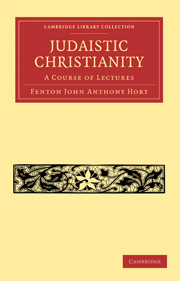Book contents
- Frontmatter
- PREFACE
- Contents
- I INTRODUCTORY LECTURE
- II CHRIST AND THE LAW
- III THE EARLY CHURCH AT JERUSALEM
- IV THE CHURCH OF ANTIOCH
- V THE INDEPENDENT ACTIVITY OF ST PAUL
- VI ST PAUL AT JERUSALEM AND THE EPISTLES OF THE ROMAN CAPTIVITY
- VII THE PASTORAL EPISTLES
- VIII JAMES, I PETER, HEBREWS, APOCALYPSE
- IX THE CHURCH OF JERUSALEM FROM TITUS TO HADRIAN
- X THE JUDAIZERS OF THE IGNATIAN EPISTLES
- XI CERINTHUS, ‘BARNABAS,’ JUSTIN MARTYR
- XII PALESTINIAN EBIONITES
- APPENDIX
- INDEX
IX - THE CHURCH OF JERUSALEM FROM TITUS TO HADRIAN
Published online by Cambridge University Press: 07 September 2011
- Frontmatter
- PREFACE
- Contents
- I INTRODUCTORY LECTURE
- II CHRIST AND THE LAW
- III THE EARLY CHURCH AT JERUSALEM
- IV THE CHURCH OF ANTIOCH
- V THE INDEPENDENT ACTIVITY OF ST PAUL
- VI ST PAUL AT JERUSALEM AND THE EPISTLES OF THE ROMAN CAPTIVITY
- VII THE PASTORAL EPISTLES
- VIII JAMES, I PETER, HEBREWS, APOCALYPSE
- IX THE CHURCH OF JERUSALEM FROM TITUS TO HADRIAN
- X THE JUDAIZERS OF THE IGNATIAN EPISTLES
- XI CERINTHUS, ‘BARNABAS,’ JUSTIN MARTYR
- XII PALESTINIAN EBIONITES
- APPENDIX
- INDEX
Summary
St James's Epistle took us just now to St James's death and the picture of him preserved by Eusebius from Hegesippus, partly to all appearance derived from the lost Ebionite book called the Steps of James. Hegesippus is likewise our authority for nearly all of the little that we know of the fortunes of the Palestinian Church for a generation or two longer.
Hegesippus.
Was he a Judaizer?
Hegesippus, who belongs to the latter half of the Second Century, stands in an interesting relation to our subject both in modern theory and in undoubted historical fact. Not long ago in the eyes of a powerful body of critics he was the most striking representative of the Judaistic Christianity of the Second Century, and this view is still in substance upheld by some. In this instance a plausible case undoubtedly existed, and it was only by a more comprehensive view of the facts and probabilities that it could be set aside. It rested not only on the ample evidence that he had special knowledge of Palestinian Christianity but also on the telling fact that he was apparently recorded as having exclaimed against words of St Paul, viz. “Eye hath not seen nor ear heard,” etc. Since however it is credibly attested that similar words occurred in an apocryphal writing, now lost, it is but reasonable to suppose that this, not I Corinthians, is the source of the quotation to which Hegesippus opposed the Lord 's words “Blessed are the eyes that see, etc.,” since otherwise there is a hopeless contradiction with known facts about Hegesippus.
- Type
- Chapter
- Information
- Judaistic ChristianityA Course of Lectures, pp. 164 - 180Publisher: Cambridge University PressPrint publication year: 2009First published in: 1894



